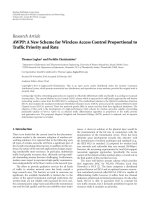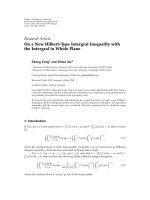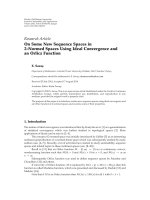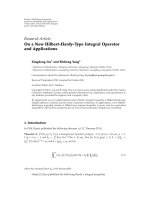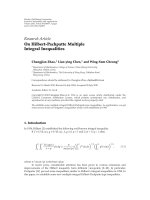Báo cáo hóa học: " Research Article On a New Hilbert-Hardy-Type Integral Operator and Applications" pptx
Bạn đang xem bản rút gọn của tài liệu. Xem và tải ngay bản đầy đủ của tài liệu tại đây (486.57 KB, 10 trang )
Hindawi Publishing Corporation
Journal of Inequalities and Applications
Volume 2010, Article ID 812636, 10 pages
doi:10.1155/2010/812636
Research Article
On a New Hilbert-Hardy-Type Integral Operator
and Applications
Xingdong Liu
1
and Bicheng Yang
2
1
Department of Mathematics, Zhaoqing University, Guangdong, Zhaoqing 526061, China
2
Department of Mathematics, Guangdong Institute of Education, Guangdong, Guangzhou 510303, China
Correspondence should be addressed to Bicheng Yang,
Received 7 September 2010; Accepted 26 October 2010
Academic Editor: Sin E. Takahasi
Copyright q 2010 X. Liu and B. Yang. This is an open access article distributed under the Creative
Commons Attribution License, which permits unrestricted use, distribution, and reproduction in
any medium, provided the original work is properly cited.
By applying the way of weight functions and a Hardy’s integral inequality, a Hilbert-Hardy-type
integral operator is defined, and the norm of operator is obtained. As applications, a new Hilbert-
Hardy-type inequality similar to Hilbert-type integral inequality is given, and two equivalent
inequalities with the best constant factors as well as some particular examples are considered.
1. Introduction
In 1934, Hardy published the following theorem cf. 1, Theorem 319.
Theorem A. If kx, y≥ 0 is a homogeneous function of degree −1 in 0, ∞ × 0, ∞, p>1,
1/p 1/q 1, and k
p
∞
0
ku, 1u
−1/p
du ∈ 0, ∞, then for fx,gy ≥ 0, 0 < f
p
:
{
∞
0
f
p
xdx}
1/p
< ∞, and 0 < g
q
< ∞, one has
∞
0
k
x, y
f
x
g
y
dx dy < k
p
f
p
g
q
,
1.1
where the constant factor k
p
is the best possible.
Hardy 2 also published the following Hardy’s integral inequality.
2 Journal of Inequalities and Applications
Theorem B. If p>1, ρ
/
1, fx ≥ 0, and Fx :
x
0
ftdtρ>1; Fx :
∞
x
ftdtρ<1,
0 <
∞
0
x
p−ρ
f
p
xdx < ∞, then one has
∞
0
x
−ρ
F
p
x
dx <
p
ρ − 1
p
∞
0
x
p−ρ
f
p
x
dx,
1.2
where the constant factor p/|ρ − 1|
p
is the best possible (cf. [1, Theorem 330]).
In 2009, Yang 3 published the following theorem.
Theorem C. If p>1, 1/p 1/q 1, λ>0, k
λ
x, y≥ 0 is a homogeneous function of degree −λ
in 0, ∞×0, ∞, and for any r>11/r 1/s 1, 0 <k
λ
r :
∞
0
k
λ
u, 1u
λ/r−1
du < ∞, then for
fx, gy ≥ 0, ϕx : x
p1−λ/r−1
, ψy : y
q1−λ/s−1
, 0 < f
p,ϕ
: {
∞
0
ϕx|fx|
p
dx}
1/p
< ∞
and 0 < g
q,ψ
< ∞, we have
∞
0
k
λ
x, y
f
x
g
y
dx dy < k
λ
r
f
p,ϕ
g
q,ψ
,
1.3
where the constant factor k
λ
r is the best possible.
For λ 1,r q, 1.3 reduces to 1.1. We name of 1.1 and 1.3 Hilbert-type integral
inequalities. Inequalities 1.1, 1.2 and 1.3 are important in analysis and its applications
cf. 4–6.
Setting k
1
x, y1/xy
γ
x
R−1/q
y
S−1/p
R, S > 0, RS γ, Fx
x
0
ftdt, Gy
y
0
gtdt, by applying 1.2for ρ p>1, Das and Sahoo gave a new integral inequality
similar to Pachpatte’s inequality cf. 7, 8 as follows:
∞
0
x
R−1/q
y
S−1/p
x y
γ
F
x
x
G
y
y
dx dy < pqB
R, S
f
p
g
q
,
1.4
where the constant factor pqBR, S is the best possible cf. 9. Sulaiman 10 also
considered a Hilbert-Hardy-type integral inequality similar to 1.4 with the kernel kx, y
1/max{x, y}
λ
x
β/q1
y
α/p1
α, β > −1, p λ − α − 1 > 1, q λ − β − 1 > 1. But he cannot
show that the constant factor in the new inequality is the best possible.
In this paper, b y applying the way of weight functions and inequality 1.2 for ρ<1,
a Hilbert-Hardy-type integral operator is defined, and the norm of operator is obtained.
As applications, a new Hilbert-Hardy-type inequality similar to 1.3 is given, and two
equivalent inequalities with a best constant factor as well as some particular examples are
considered.
Journal of Inequalities and Applications 3
2. A Lemma and Two Equivalent Inequalities
Lemma 2.1. If λ<2, k
λ
x, y is a nonnegative homogeneous function of degree −λ in 0, ∞ ×
0, ∞ with k
λ
ux, uyu
−λ
kx, yu, x, y > 0, and for any α ∈ λ − 1, 1, 0 <kα :
∞
0
k
λ
1,uu
α−1
du < ∞, then
∞
0
k
λ
u, 1u
λ−α−1
du kα and
0 <
∞
0
k
λ
1,u
u
α−1
|
ln u
|
du
∞
0
k
λ
u, 1
u
λ−α−1
|
ln u
|
du < ∞.
2.1
Proof. Setting v 1/u, we find
∞
0
k
λ
u, 1
u
λ−α−1
du
∞
0
k
λ
1,v
v
α−1
dv k
α
.
2.2
There exists β>0, satisfying α ± β ∈ λ − 1, 1 and 0 <kα ± β < ∞. Since we find
lim
u → 0
ln u
u
β
u
−β
lim
u →∞
ln u
u
β
u
−β
0,
2.3
there exists M>0, such that | ln u|≤Mu
β
u
−β
u ∈ 0, ∞, and then
0 <
∞
0
k
λ
u, 1
u
λ−α−1
|
ln u
|
du
∞
0
k
λ
1,u
u
α−1
|
ln u
|
du
≤ M
∞
0
k
λ
1,u
u
α−1
u
β
u
−β
du
M
k
α β
k
α − β
< ∞.
2.4
The lemma is proved.
Theorem 2.2. If p>1, 1/p 1/q 1, λ
1
λ
2
λ<2, k
λ
x, y≥ 0 is a homogeneous function of
degree −λ in 0, ∞ × 0, ∞, and for any λ
1
∈ λ − 1, 1, 0 <kλ
1
∞
0
ku, 1u
λ
1
−1
du < ∞, then
for fx,gy ≥ 0, ϕx : x
p2−λ−λ
1
−1
, ψy : y
q1−λ
2
−1
,
F
λ
x
:
∞
x
1
t
λ
f
t
dt,
G
λ
y
:
∞
y
1
t
λ
g
t
dt,
2.5
0 < f
p, ϕ
< ∞, and 0 <
G
λ
q,ψ
< ∞, one has the following equivalent inequalities:
I :
∞
0
k
λ
x, y
F
λ
x
G
λ
y
dx dy <
k
λ
1
1 − λ
1
f
p, ϕ
G
λ
q,ψ
,
2.6
J :
∞
0
ψ
1−p
y
∞
0
k
λ
x, y
F
λ
xdx
p
dy
1/p
<
k
λ
1
1 − λ
1
f
p, ϕ
.
2.7
4 Journal of Inequalities and Applications
Proof. Setting the weight functions ωλ
1
,y and λ
2
,x as follows:
ω
λ
1
,y
:
∞
0
k
λ
x, y
y
λ
2
dx
x
1−λ
1
,
λ
2
,x
:
∞
0
k
λ
x, y
x
λ
1
dy
y
1−λ
2
,
2.8
then by Lemma 2.1 ,wefind
ω
λ
1
,y
ux/y
∞
0
k
u, 1
u
λ
1
−1
du k
λ
1
,
λ
2
,x
uy/x
∞
0
k
1,u
u
λ
2
−1
du k
λ
1
.
2.9
By H
¨
older’s inequality cf. 11 and 2.8, 2.9,weobtain
∞
0
k
λ
x, y
F
λ
x
dx
∞
0
k
λ
x, y
x
1−λ
1
/q
y
1−λ
2
/p
F
λ
x
y
1−λ
2
/p
x
1−λ
1
/q
dx
≤
∞
0
k
λ
x, y
x
1−λ
1
p−1
y
1−λ
2
F
p
λ
xdx
1/p
×
y
q1−λ
2
−1
∞
0
k
λ
x, y
y
λ
2
dx
x
1−λ
1
1/q
k
1/q
λ
1
y
1/p−λ
2
∞
0
k
λ
x, y
x
1−λ
1
p−1
y
1−λ
2
F
p
λ
xdx
1/p
.
2.10
Then by Fubini theorem cf. 12, it follows:
J
p
≤ k
p−1
λ
1
∞
0
k
λ
x, y
x
1−λ
1
p−1
y
1−λ
2
F
p
λ
x
dx dy
k
p−1
λ
1
∞
0
∞
0
k
λ
x, y
x
1−λ
1
p−1
y
1−λ
2
dy
F
p
λ
x
dx
k
p
λ
1
∞
0
x
−pλ
1
−11
F
p
λ
x
dx.
2.11
Since λ
1
< 1, ρ pλ
1
− 11 < 1, then by 1.2for ρ<1, we have
∞
0
x
−pλ
1
−11
F
p
λ
x
dx <
1
1 − λ
1
p
∞
0
x
p−pλ
1
−11
fx
x
λ
p
dx
1
1 − λ
1
p
∞
0
x
p2−λ−λ
1
−1
f
p
x
dx.
2.12
Journal of Inequalities and Applications 5
Hence by 2.11, we have 2.7. Still by H
¨
older’s inequality, we find
I
∞
0
ψ
−1/q
y
∞
0
k
λ
x, y
F
λ
x
dx
ψ
1/q
y
G
λ
y
dy ≤ J
G
λ
q,ψ
.
2.13
Then by 2.7, we have 2.6.
On the other-hand, supposing that 2.6 is valid, by 2.11 and 1.2for ρ<1,it
follows J<∞. If J 0, then 2.7 is naturally valid; if 0 <J<∞, setting
G
λ
y
ψ
1−p
y
∞
0
k
λ
x, y
F
λ
xdx
p−1
,
2.14
then by 2.6,wefind
G
λ
q
q,ψ
J
p
I<
k
λ
1
1 − λ
1
f
p, ϕ
G
λ
q,ψ
,
G
λ
q−1
q,ψ
J<
k
λ
1
1 − λ
1
f
p, ϕ
.
2.15
Hence, we have 2.7, which is equivalent to 2.6.
3. A Hilbert-Hardy-Type Integral Operator and Applications
Setting a real function space as follows:
L
p
ϕ
0, ∞
:
f;
f
p, ϕ
∞
0
ϕ
x
f
x
p
dx
1/p
< ∞
, 3.1
for f≥ 0 ∈ L
p
ϕ
0, ∞,
F
λ
x
∞
x
ft/t
λ
dt, define an integral operator T : L
p
ϕ
0, ∞ →
L
p
ψ
1−p
0, ∞ as follows:
Tf
y
:
∞
0
k
λ
x, y
F
λ
x
dx, y ∈
0, ∞
.
3.2
Then, by 2.7, Tf ∈ L
p
ψ
1−p
0, ∞,andT is bounded with
T
sup
f
/
θ∈L
p
ϕ
0,∞
Tf
p,ψ
1−p
f
p, ϕ
≤
k
λ
1
1 − λ
1
.
3.3
6 Journal of Inequalities and Applications
Theorem 3.1. Let the assumptions of Theorem 2.2 be fulfilled, and additionally setting ψy :
y
q2−λ−λ
2
−1
. Then one has
∞
0
k
λ
x, y
F
λ
x
G
λ
y
dx dy <
k
λ
1
1 − λ
1
1 − λ
2
f
p, ϕ
g
q,ψ
, 3.4
where the constant factor kλ
1
/1 − λ
1
1 − λ
2
is the best possible. Moreover the constant factor in
2.6 and 2.7 is the best possible and then
T
k
λ
1
1 − λ
1
.
3.5
Proof. Since λ
2
< 1, by 1.2,forρ qλ
2
− 11 < 1, it follows:
G
λ
q,ψ
∞
0
y
−qλ
2
−11
G
q
λ
y
dy
1/q
<
q
1 −
q
λ
2
− 1
1
∞
0
y
q−qλ
2
−11
gy
y
λ
q
dy
1/q
1
1 − λ
2
∞
0
y
q2−λ−λ
2
−1
g
q
ydy
1/q
1
1 − λ
2
g
q,ψ
.
3.6
Then, by 2.6, we have 3.4.
For T>2, setting
fx, gy as follows:
f
x
⎧
⎪
⎪
⎨
⎪
⎪
⎩
x
λλ
1
−2
, 1 ≤ x ≤ T,
0, 0 <x<1; x>T,
g
y
⎧
⎪
⎪
⎨
⎪
⎪
⎩
y
λλ
2
−2
, 1 ≤ y ≤ T,
0, 0 <y<1; y>T,
3.7
Journal of Inequalities and Applications 7
then for 1 ≤ x, y ≤ T, we find
F
λ
x
∞
x
f
t
t
λ
dt
T
x
t
λ
1
−2
dt
1
1 − λ
1
x
λ
1
−1
− T
λ
1
−1
,
G
λ
y
∞
y
g
t
t
λ
dt
1
1 − λ
2
y
λ
2
−1
− T
λ
2
−1
,
I :
T
1
k
λ
x, y
F
λ
x
G
λ
y
dx dy
1
1 − λ
1
1 − λ
2
×
T
1
T
1
k
λ
x, y
x
λ
1
−1
− T
λ
1
−1
y
λ
2
−1
− T
λ
2
−1
dy
dx
≥
1
1 − λ
1
1 − λ
2
I
1
− I
2
− I
3
,
3.8
where I
1
, I
2
,andI
3
are indicated as follows;
I
1
:
T
1
T
1
k
λ
x, y
x
λ
1
−1
y
λ
2
−1
dy
dx,
I
2
: T
λ
1
−1
T
1
T
1
k
λ
x, y
y
λ
2
−1
dy
dx,
I
3
: T
λ
2
−1
T
1
T
1
k
λ
x, y
x
λ
1
−1
dx
dy.
3.9
If there exists a positive constant k ≤ kλ
1
, such that 3.4 is still valid as we replace
kλ
1
by k, then in particular, we find
I<
k
1 − λ
1
1 − λ
2
f
p, ϕ
g
q,ψ
k
1 − λ
1
1 − λ
2
T
1
x
p2−λ−λ/r−1
x
pλλ/r−2
dx
1/p
×
T
1
y
q2−λ−λ/s−1
y
qλλ/s−2
dy
1/q
k ln T
1 − λ
1
1 − λ
2
.
3.10
By 3.8 and 3.10 ,wefind
1
ln T
I
1
−
1
ln T
I
2
I
3
<k.
3.11
8 Journal of Inequalities and Applications
Since by Fubini t heorem, we obtain
I
1
T
1
1
x
T/x
1/x
k
λ
1,u
u
λ
2
−1
du dx
1
0
T
1/u
1
x
dx
k
λ
1,u
u
λ
2
−1
du
T
1
T/u
1
1
x
dx
k
λ
1,u
u
λ
2
−1
du
ln T
1
0
k
λ
1,u
u
λ
2
−1
du
1
ln T
1
0
k
λ
1,u
ln u
u
λ
2
−1
du
T
1
k
λ
1,u
u
λ
2
−1
du −
1
ln T
T
1
k
λ
1,u
ln u
u
λ
2
−1
du
,
0 ≤ I
2
T
λ
1
−1
T
1
1
x
λ
1
T/x
1/x
k
λ
1,u
u
λ
2
−1
dudx
T
λ
1
−1
1
0
T
1/u
1
x
λ
1
dx
k
λ
1,u
u
λ
2
−1
du
T
1
T/u
1
1
x
λ
1
dx
k
λ
1,u
u
λ
2
−1
du
1
1 − λ
1
1
0
1
u
T
1−λ
1
k
λ
1,u
u
λ
2
−1
du
T
1
1 −
u
T
1−λ
1
k
λ
1,u
u
λ
2
−1
du
≤
1
1 − λ
1
2
1
0
k
λ
1,u
u
λ
2
−1
du
∞
1
k
λ
1,u
u
λ
2
−1
du
< ∞,
0 ≤ I
3
≤
1
1 − λ
2
2
1
0
k
λ
u, 1
u
λ
1
−1
du
∞
1
k
λ
u, 1
u
λ
1
−1
du
< ∞,
3.12
then for T →∞in 3.10, by Lemma 2.1,weobtainkλ
1
∞
0
k1,uu
λ
2
−1
du ≤ k. Hence
k kλ
1
, and then kλ
1
/1 − λ
1
1 − λ
2
is the best value of 3.4.
We conclude that the constant factor in 2.6 is the best possible, otherwise we can
get a contradiction by 1.2 that the constant factor in 3.4 is not the best possible. By the
same way, if the constant factor in 2.7 is not the best possible, then by 2.13, we can get
a contradiction that the constant factor in 2.6 is not the best possible. T herefore in view of
3.3, we have 3.5.
Journal of Inequalities and Applications 9
Corollary 3.2. For λ 1, λ
1
1/q, λ
2
1/p,
F
1
x :
∞
x
1/tftdt,
G
1
y :
∞
y
1/tgtdt,
in 2.6, 2.7 and 3.4, one has the following basic Hilbert-Hardy-type integral inequalities with the
best constant factors:
∞
0
k
1
x, y
F
1
x
G
1
y
dx dy < pk
p
f
p
G
1
q
,
3.13
∞
0
∞
0
k
1
x, y
F
1
xdx
p
dy
1/p
<pk
p
f
p
, 3.14
∞
0
k
1
x, y
F
1
x
G
1
y
dx dy < pqk
p
f
p
g
q
,
3.15
where k
p
k1/q
∞
0
k
λ
u, 1u
−1/p
du, and 3.13 is equivalent to 3.14.
Example 3.3. For p>1, r>1, 1/p 1/q 1/r 1/s 1, λ
1
λ/r,andλ
2
λ/s in3.4,
a if 0 <λ<max{r, s}, k
λ
x, y1/x y
λ
,1/max{x, y}
λ
and lnx/y/x
λ
− y
λ
,
then we obtain the following integral inequalities:
∞
0
F
λ
x
G
λ
y
x y
λ
dx dy <
rsB
λ/r, λ/s
r − λ
s − λ
f
p, ϕ
g
q,ψ
,
∞
0
F
λ
x
G
λ
y
max
x, y
λ
dx dy <
r
2
s
2
λ
r − λ
s − λ
f
p, ϕ
g
q,ψ
,
∞
0
ln
x/y
F
λ
x
G
λ
y
x
λ
− y
λ
dx dy <
rs
πcsc
π/r
2
λ
2
r − λ
s − λ
f
p, ϕ
g
q,ψ
;
3.16
b if 0 <λ<1,k
λ
x, y1/|x − y|
λ
, then we have
∞
0
F
λ
x
G
λ
y
x − y
λ
dx dy <
rs
B
1 − λ, λ/r
B
1 − λ, λ/s
r − λ
s − λ
f
p, ϕ
g
q,ψ
;
3.17
c if λ<0,k
λ
x, ymin{x, y}
−λ
, then we find
∞
0
F
λ
x
G
λ
y
min
x, y
λ
dx dy <
−r
2
s
2
λ
r − λ
s − λ
f
p, ϕ
g
q,ψ
,
3.18
where the constant factors in the above inequalities are the best possible.
10 Journal of Inequalities and Applications
Acknowledgments
This work is supported by the Emphases Natural Science Foundation of Guangdong Insti-
tution, Higher Learning, College and University no. 05Z026 and the Guangdong Natural
Science Foundation no. 7004344.
References
1 G. H. Hardy, J. E. Littlewood, and G. Polya, Inequalities, Cambridge University Press, Cambridge, UK,
1934.
2 G. H. Hardy, “Note on some points in the integral calculus LXIV,” Messenger of Math,vol.57,pp.
12–16, 1928.
3 B. Yang, “A survey of the study of Hilbert-type inequalities with parameters,” Advances in Math, vol.
38, no. 3, pp. 257–268, 2009.
4 D. S. Mintrinovic, J. E. Pecaric, and A. M. Kink, Inequalities Involving Functions and their Integrals and
Derivertives, Kluwer Academic Publishers, Boston, Mass, USA, 1991.
5 B. Yang, The Norm of Operator and Hilbert-Type Inequalities, Science, Beijin, China, 2009.
6 B. Yang, “On the norm of a Hilbert’s type linear operator and applications,” Journal of Mathematical
Analysis and Applications, vol. 325, no. 1, pp. 529–541, 2007.
7 B. G. Pachpatte, “On some new inequalities similar to Hilbert’s inequality,” Journal of Mathematical
Analysis and Applications, vol. 226, no. 3, pp. 166–179, 1998.
8 B. G. Pachpatte, “Inequalities similar to certain extensions of Hilbert’s inequality,” Journal of
Mathematical Analysis and Applications, vol. 243, no. 2, pp. 217–227, 2000.
9 N. Das and S. Sahoo, “New inequalities similar to Hardy-Hilbert’s inequality,” Turkish Journal of
Mathematics, vol. 33, pp. 1–13, 2009.
10 W. T. Sulaiman, “On three inequalities similar to Hardy-Hilbert’s integral inequality,” Acta
Mathematica Universitatis Comenianae, vol. 76, no. 2, pp. 273–278, 2007.
11 J. Kuang, Applied Inequalities, Shangdong Science Technic, Jinan, China, 2004.
12 J. Kuang, Introduction to Real Analysis, Hunan Education, Changsha, China, 1996.
